Chief Arvol Looking Horse is the 19th Keeper of the Sacred Bundle and Spiritual Leader of the Lakota, Dakota, Nakota People.
One year after the closing of the camp at the Standing Rock Reservation, Standing Rock is everywhere. Our collective water has been assaulted for many generations to the possible point of no return.
Our Elders foretold of a Black Snake and how the Water of Life — “Mni Woc’oni,” which is our first medicine — would be affected if we did not stop this oncoming disaster. Mni Woc’oni is part of our creation story, and the same story that exists in many creation stories around Mother Earth.
When we say “Mni Woc’oni” — Water of Life — people all over the world are now beginning to understand that it is a living spirit: it can heal when you pray with it and die if you do not respect it. We wanted the world to know there have been warnings in our prophecies and, as we see it, those warnings are now taking place. It was said water would be like gold. It was said that our spirit of water would begin to leave us.
We are at the crossroads.
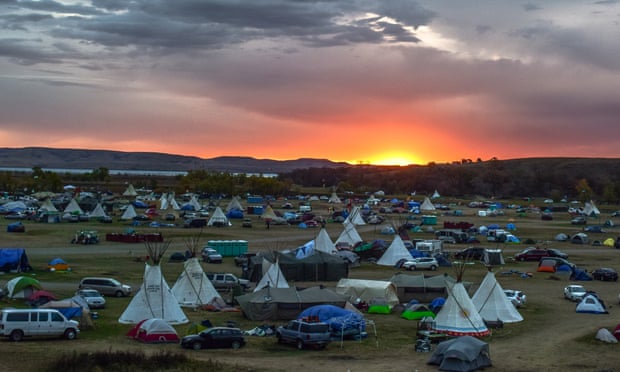
First sunrise begins to creep onto Oceti Sakowin Camp, October 19th, 2016. Photograph: Ryan Vizzions
In April 2016, after receiving concerns about the construction of an oil pipeline, I was invited to Sacred Stone Camp at the northeastern border of the Standing Rock Reservation in North Dakota to assist with a water ceremony. At that time, not many were there, but it was enough to create a prayer to wake up the people. I told the young people that Standing Rock is everywhere.
Later that month, our indigenous youth set out on foot to run from the Standing Rock Reservation to Washington D.C. in an attempt to bring attention to the poisonous bitumen oil pipeline coming through our treaty territory. For our young people, it was important to explain to U.S. government leaders that this was unacceptable.
As I look back at my experiences at Standing Rock, I think about the circle we created through prayer on December 4, 2016. Our traditional Elders asked all nations to join us and stand in prayer. Thousands, including many religious representatives, joined in prayer on that very cold day. An invitation video was made and sent all over the world.
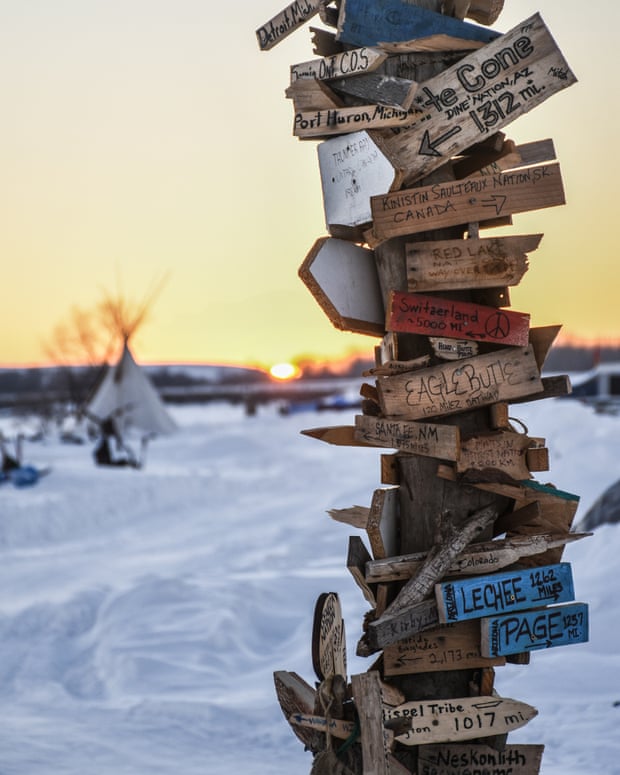
A signpost pointing to home, erected in Fall 2016 by those who came to camp at Standing Rock. It is now on display on the Smithsonian Museum in Washington, DC. Photograph: Ryan Vizzions
After the prayers were offered to the fire, I asked the people to surround the camp and ride horseback around the whole perimeter. On this day, President Obama and his administration halted the Dakota Access Pipeline by denying the U.S. Army Corps of Engineers an easement that would have allowed the pipeline to cross beneath Lake Oahe.
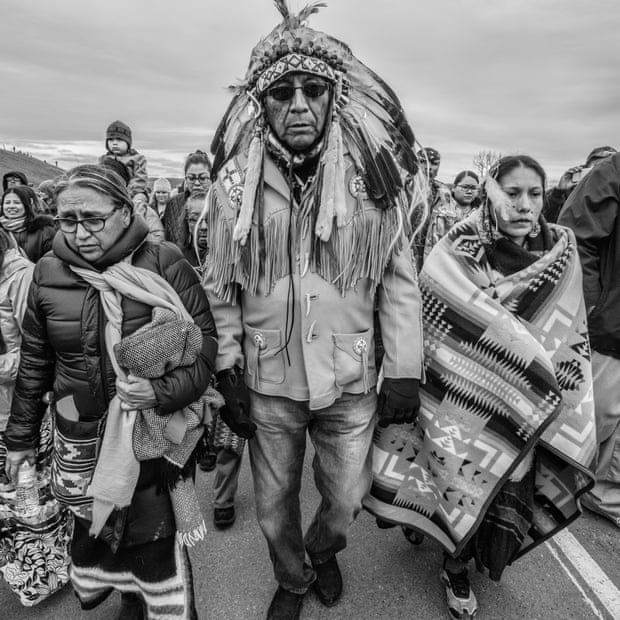
Chief Arvol and Paula Looking Horse and other water protectors walking away from a meeting with law enforcement on the Backwater Bridge at Standing Rock, with a prayer song. Photograph: Ryan Vizzions
The closing of the camp at Standing Rock a year ago and the continued construction of the Dakota Access Pipeline has been a great disappointment. So, too, was the November 2017 spill of 210,000 gallons of oil from the Keystone Pipeline, west of the Sisseton Wahpeton Reservation, despite the tribe’s fight against it since 2003. So, too, was the April 2011 spill of 1.2 million gallons of oil onto Lubicon Cree territory, northeast of Peace River.
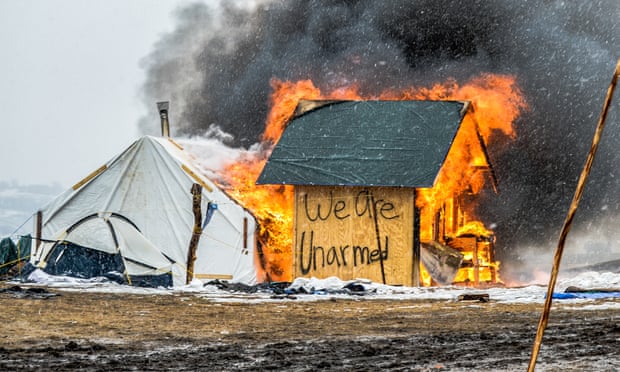
At Standing Rock, water protectors chose to ceremonially burn the camp and its sacred structures, rather than have it bulldozed by outside forces. Photograph: Rob Wilson
What happened at Standing Rock has awakened many of my own people, and people across the world.
It was at Standing Rock that so many came together to share their stories and knowledge of what was happening in their territory, sharing ideas on how to move toward sustainable living in our relationship to land, water, and food.
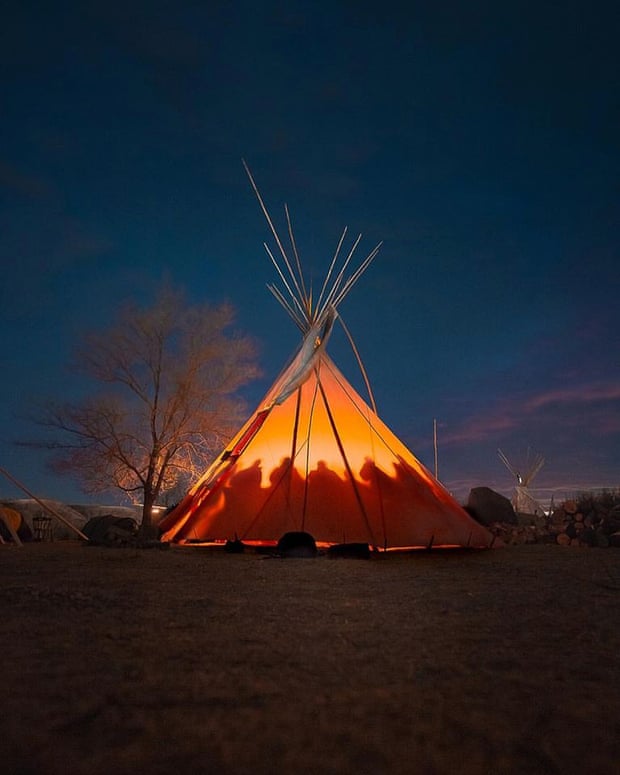
Women water protectors gather to strategize at nightfall. Photograph: Tomas Karmelo Amaya
Standing Rock has marked the beginning of an international movement that will continue to work peacefully, purposefully, and tirelessly for the protection of water along all areas of poisonous oil pipelines and across all of Mother Earth.
In the protection of Mni Woc’oni, it is more than oil pipelines threatening the well-being and future of our water. Near the native territory of the Sisseton Wahpeton Oyate, concentrated animal feeding operations or “CAFOs” are draining and degrading the land and water. As a result, the air is toxic, swamps have dried up, and aquifers, to which the people are supposed to have water rights, are being drained. Residents have mortgaged their homes to fight these threats in court and lost. In other places — in mining spills across South America and Africa and at Fukushima — man has gone too far.
Water is a source of life, not a resource.
from Skeptical Science http://ift.tt/2FpVAg1
Chief Arvol Looking Horse is the 19th Keeper of the Sacred Bundle and Spiritual Leader of the Lakota, Dakota, Nakota People.
One year after the closing of the camp at the Standing Rock Reservation, Standing Rock is everywhere. Our collective water has been assaulted for many generations to the possible point of no return.
Our Elders foretold of a Black Snake and how the Water of Life — “Mni Woc’oni,” which is our first medicine — would be affected if we did not stop this oncoming disaster. Mni Woc’oni is part of our creation story, and the same story that exists in many creation stories around Mother Earth.
When we say “Mni Woc’oni” — Water of Life — people all over the world are now beginning to understand that it is a living spirit: it can heal when you pray with it and die if you do not respect it. We wanted the world to know there have been warnings in our prophecies and, as we see it, those warnings are now taking place. It was said water would be like gold. It was said that our spirit of water would begin to leave us.
We are at the crossroads.

First sunrise begins to creep onto Oceti Sakowin Camp, October 19th, 2016. Photograph: Ryan Vizzions
In April 2016, after receiving concerns about the construction of an oil pipeline, I was invited to Sacred Stone Camp at the northeastern border of the Standing Rock Reservation in North Dakota to assist with a water ceremony. At that time, not many were there, but it was enough to create a prayer to wake up the people. I told the young people that Standing Rock is everywhere.
Later that month, our indigenous youth set out on foot to run from the Standing Rock Reservation to Washington D.C. in an attempt to bring attention to the poisonous bitumen oil pipeline coming through our treaty territory. For our young people, it was important to explain to U.S. government leaders that this was unacceptable.
As I look back at my experiences at Standing Rock, I think about the circle we created through prayer on December 4, 2016. Our traditional Elders asked all nations to join us and stand in prayer. Thousands, including many religious representatives, joined in prayer on that very cold day. An invitation video was made and sent all over the world.

A signpost pointing to home, erected in Fall 2016 by those who came to camp at Standing Rock. It is now on display on the Smithsonian Museum in Washington, DC. Photograph: Ryan Vizzions
After the prayers were offered to the fire, I asked the people to surround the camp and ride horseback around the whole perimeter. On this day, President Obama and his administration halted the Dakota Access Pipeline by denying the U.S. Army Corps of Engineers an easement that would have allowed the pipeline to cross beneath Lake Oahe.

Chief Arvol and Paula Looking Horse and other water protectors walking away from a meeting with law enforcement on the Backwater Bridge at Standing Rock, with a prayer song. Photograph: Ryan Vizzions
The closing of the camp at Standing Rock a year ago and the continued construction of the Dakota Access Pipeline has been a great disappointment. So, too, was the November 2017 spill of 210,000 gallons of oil from the Keystone Pipeline, west of the Sisseton Wahpeton Reservation, despite the tribe’s fight against it since 2003. So, too, was the April 2011 spill of 1.2 million gallons of oil onto Lubicon Cree territory, northeast of Peace River.

At Standing Rock, water protectors chose to ceremonially burn the camp and its sacred structures, rather than have it bulldozed by outside forces. Photograph: Rob Wilson
What happened at Standing Rock has awakened many of my own people, and people across the world.
It was at Standing Rock that so many came together to share their stories and knowledge of what was happening in their territory, sharing ideas on how to move toward sustainable living in our relationship to land, water, and food.

Women water protectors gather to strategize at nightfall. Photograph: Tomas Karmelo Amaya
Standing Rock has marked the beginning of an international movement that will continue to work peacefully, purposefully, and tirelessly for the protection of water along all areas of poisonous oil pipelines and across all of Mother Earth.
In the protection of Mni Woc’oni, it is more than oil pipelines threatening the well-being and future of our water. Near the native territory of the Sisseton Wahpeton Oyate, concentrated animal feeding operations or “CAFOs” are draining and degrading the land and water. As a result, the air is toxic, swamps have dried up, and aquifers, to which the people are supposed to have water rights, are being drained. Residents have mortgaged their homes to fight these threats in court and lost. In other places — in mining spills across South America and Africa and at Fukushima — man has gone too far.
Water is a source of life, not a resource.
from Skeptical Science http://ift.tt/2FpVAg1

Aucun commentaire:
Enregistrer un commentaire